H&M: Report on Business Operations, Accounting and HR Functions
VerifiedAdded on 2021/01/13
|10
|2459
|276
Report
AI Summary
This report analyzes H&M's business operations, covering various aspects like organizational structures, public and private sector types, and the impact of the economic environment. It delves into the importance of accounting for business success, outlining the functions of the HR department and key features of employment legislation. The report includes a workshop on interpreting profit and loss accounts, an analysis of team roles and development stages, and an examination of motivation theories and leadership styles. Furthermore, it explores the impact of customer service and the benefits of customer profiling on business success, providing a comprehensive overview of H&M's operational strategies and management practices. The report concludes with a summary of key findings and references to supporting literature.
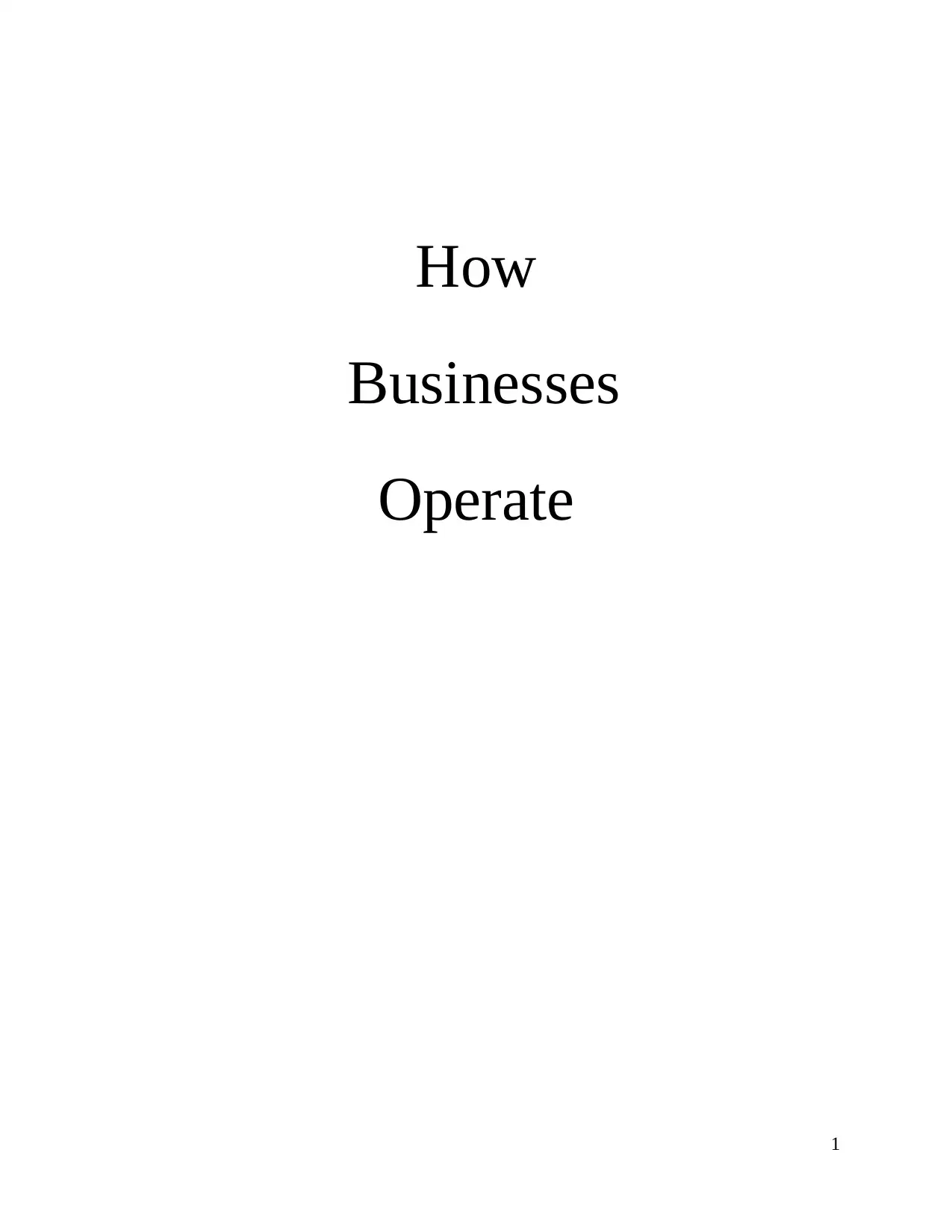
How
Businesses
Operate
1
Businesses
Operate
1
Paraphrase This Document
Need a fresh take? Get an instant paraphrase of this document with our AI Paraphraser
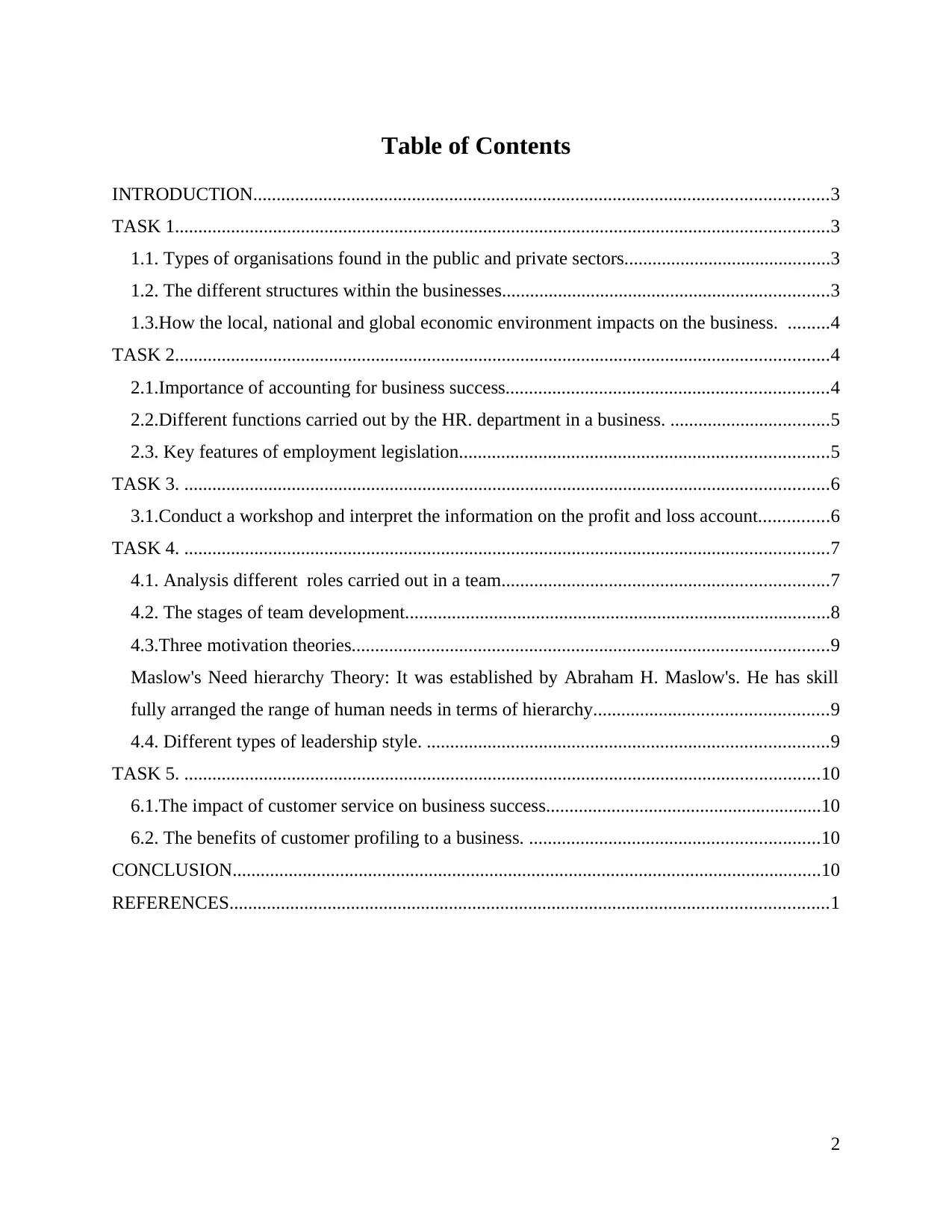
Table of Contents
INTRODUCTION...........................................................................................................................3
TASK 1............................................................................................................................................3
1.1. Types of organisations found in the public and private sectors............................................3
1.2. The different structures within the businesses......................................................................3
1.3.How the local, national and global economic environment impacts on the business. .........4
TASK 2............................................................................................................................................4
2.1.Importance of accounting for business success.....................................................................4
2.2.Different functions carried out by the HR. department in a business. ..................................5
2.3. Key features of employment legislation...............................................................................5
TASK 3. ..........................................................................................................................................6
3.1.Conduct a workshop and interpret the information on the profit and loss account...............6
TASK 4. ..........................................................................................................................................7
4.1. Analysis different roles carried out in a team......................................................................7
4.2. The stages of team development...........................................................................................8
4.3.Three motivation theories......................................................................................................9
Maslow's Need hierarchy Theory: It was established by Abraham H. Maslow's. He has skill
fully arranged the range of human needs in terms of hierarchy..................................................9
4.4. Different types of leadership style. ......................................................................................9
TASK 5. ........................................................................................................................................10
6.1.The impact of customer service on business success...........................................................10
6.2. The benefits of customer profiling to a business. ..............................................................10
CONCLUSION..............................................................................................................................10
REFERENCES................................................................................................................................1
2
INTRODUCTION...........................................................................................................................3
TASK 1............................................................................................................................................3
1.1. Types of organisations found in the public and private sectors............................................3
1.2. The different structures within the businesses......................................................................3
1.3.How the local, national and global economic environment impacts on the business. .........4
TASK 2............................................................................................................................................4
2.1.Importance of accounting for business success.....................................................................4
2.2.Different functions carried out by the HR. department in a business. ..................................5
2.3. Key features of employment legislation...............................................................................5
TASK 3. ..........................................................................................................................................6
3.1.Conduct a workshop and interpret the information on the profit and loss account...............6
TASK 4. ..........................................................................................................................................7
4.1. Analysis different roles carried out in a team......................................................................7
4.2. The stages of team development...........................................................................................8
4.3.Three motivation theories......................................................................................................9
Maslow's Need hierarchy Theory: It was established by Abraham H. Maslow's. He has skill
fully arranged the range of human needs in terms of hierarchy..................................................9
4.4. Different types of leadership style. ......................................................................................9
TASK 5. ........................................................................................................................................10
6.1.The impact of customer service on business success...........................................................10
6.2. The benefits of customer profiling to a business. ..............................................................10
CONCLUSION..............................................................................................................................10
REFERENCES................................................................................................................................1
2
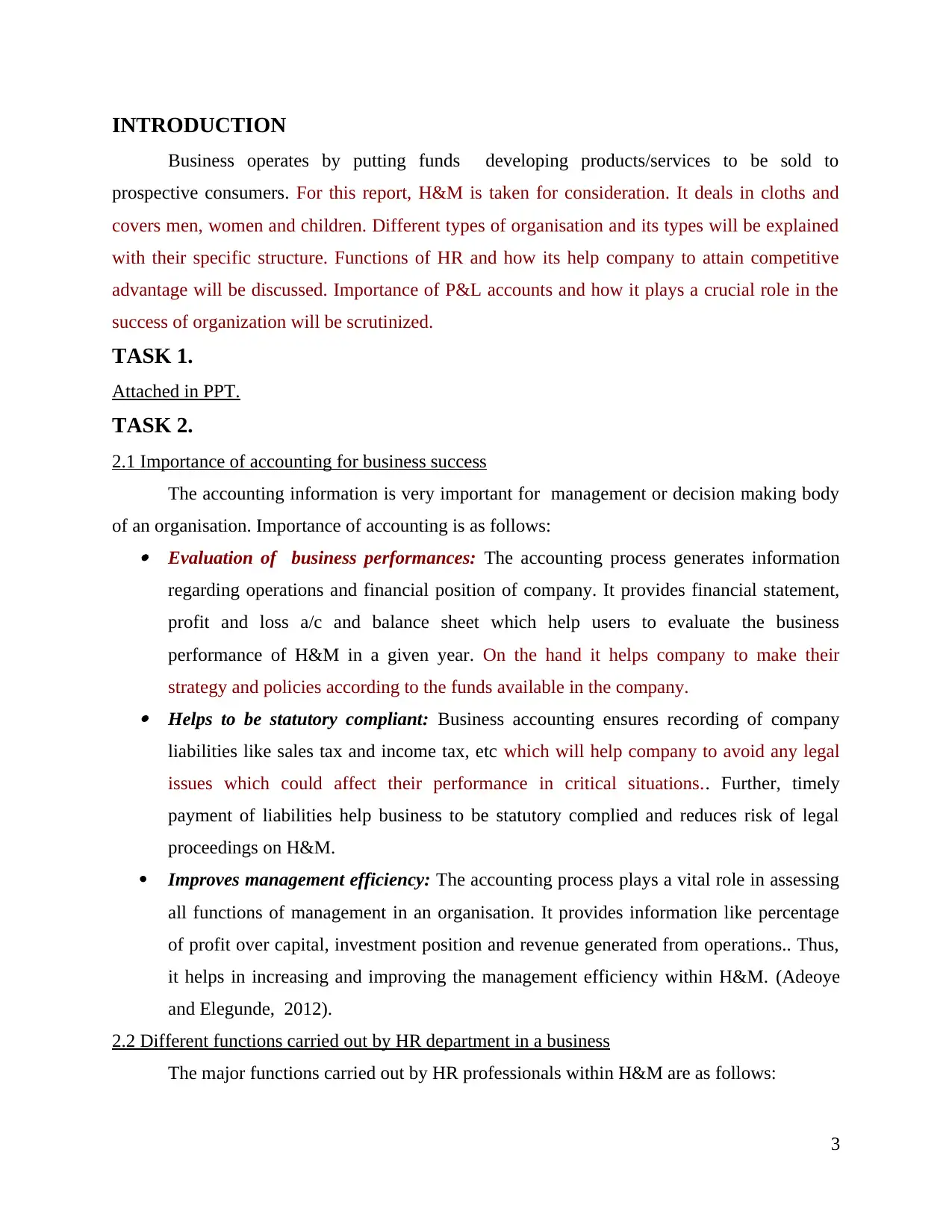
INTRODUCTION
Business operates by putting funds developing products/services to be sold to
prospective consumers. For this report, H&M is taken for consideration. It deals in cloths and
covers men, women and children. Different types of organisation and its types will be explained
with their specific structure. Functions of HR and how its help company to attain competitive
advantage will be discussed. Importance of P&L accounts and how it plays a crucial role in the
success of organization will be scrutinized.
TASK 1.
Attached in PPT.
TASK 2.
2.1 Importance of accounting for business success
The accounting information is very important for management or decision making body
of an organisation. Importance of accounting is as follows: Evaluation of business performances: The accounting process generates information
regarding operations and financial position of company. It provides financial statement,
profit and loss a/c and balance sheet which help users to evaluate the business
performance of H&M in a given year. On the hand it helps company to make their
strategy and policies according to the funds available in the company. Helps to be statutory compliant: Business accounting ensures recording of company
liabilities like sales tax and income tax, etc which will help company to avoid any legal
issues which could affect their performance in critical situations.. Further, timely
payment of liabilities help business to be statutory complied and reduces risk of legal
proceedings on H&M.
Improves management efficiency: The accounting process plays a vital role in assessing
all functions of management in an organisation. It provides information like percentage
of profit over capital, investment position and revenue generated from operations.. Thus,
it helps in increasing and improving the management efficiency within H&M. (Adeoye
and Elegunde, 2012).
2.2 Different functions carried out by HR department in a business
The major functions carried out by HR professionals within H&M are as follows:
3
Business operates by putting funds developing products/services to be sold to
prospective consumers. For this report, H&M is taken for consideration. It deals in cloths and
covers men, women and children. Different types of organisation and its types will be explained
with their specific structure. Functions of HR and how its help company to attain competitive
advantage will be discussed. Importance of P&L accounts and how it plays a crucial role in the
success of organization will be scrutinized.
TASK 1.
Attached in PPT.
TASK 2.
2.1 Importance of accounting for business success
The accounting information is very important for management or decision making body
of an organisation. Importance of accounting is as follows: Evaluation of business performances: The accounting process generates information
regarding operations and financial position of company. It provides financial statement,
profit and loss a/c and balance sheet which help users to evaluate the business
performance of H&M in a given year. On the hand it helps company to make their
strategy and policies according to the funds available in the company. Helps to be statutory compliant: Business accounting ensures recording of company
liabilities like sales tax and income tax, etc which will help company to avoid any legal
issues which could affect their performance in critical situations.. Further, timely
payment of liabilities help business to be statutory complied and reduces risk of legal
proceedings on H&M.
Improves management efficiency: The accounting process plays a vital role in assessing
all functions of management in an organisation. It provides information like percentage
of profit over capital, investment position and revenue generated from operations.. Thus,
it helps in increasing and improving the management efficiency within H&M. (Adeoye
and Elegunde, 2012).
2.2 Different functions carried out by HR department in a business
The major functions carried out by HR professionals within H&M are as follows:
3
⊘ This is a preview!⊘
Do you want full access?
Subscribe today to unlock all pages.

Trusted by 1+ million students worldwide
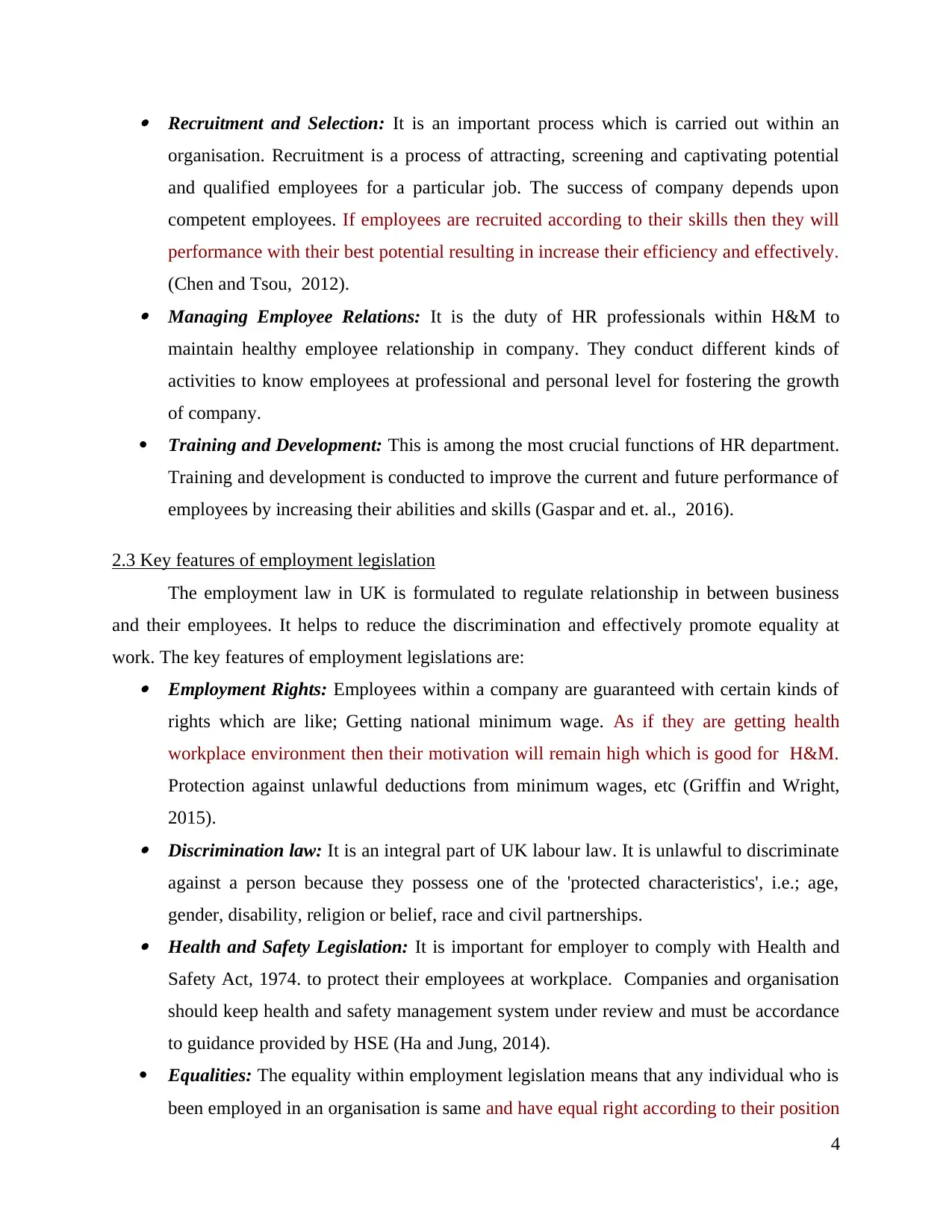
Recruitment and Selection: It is an important process which is carried out within an
organisation. Recruitment is a process of attracting, screening and captivating potential
and qualified employees for a particular job. The success of company depends upon
competent employees. If employees are recruited according to their skills then they will
performance with their best potential resulting in increase their efficiency and effectively.
(Chen and Tsou, 2012). Managing Employee Relations: It is the duty of HR professionals within H&M to
maintain healthy employee relationship in company. They conduct different kinds of
activities to know employees at professional and personal level for fostering the growth
of company.
Training and Development: This is among the most crucial functions of HR department.
Training and development is conducted to improve the current and future performance of
employees by increasing their abilities and skills (Gaspar and et. al., 2016).
2.3 Key features of employment legislation
The employment law in UK is formulated to regulate relationship in between business
and their employees. It helps to reduce the discrimination and effectively promote equality at
work. The key features of employment legislations are: Employment Rights: Employees within a company are guaranteed with certain kinds of
rights which are like; Getting national minimum wage. As if they are getting health
workplace environment then their motivation will remain high which is good for H&M.
Protection against unlawful deductions from minimum wages, etc (Griffin and Wright,
2015). Discrimination law: It is an integral part of UK labour law. It is unlawful to discriminate
against a person because they possess one of the 'protected characteristics', i.e.; age,
gender, disability, religion or belief, race and civil partnerships. Health and Safety Legislation: It is important for employer to comply with Health and
Safety Act, 1974. to protect their employees at workplace. Companies and organisation
should keep health and safety management system under review and must be accordance
to guidance provided by HSE (Ha and Jung, 2014).
Equalities: The equality within employment legislation means that any individual who is
been employed in an organisation is same and have equal right according to their position
4
organisation. Recruitment is a process of attracting, screening and captivating potential
and qualified employees for a particular job. The success of company depends upon
competent employees. If employees are recruited according to their skills then they will
performance with their best potential resulting in increase their efficiency and effectively.
(Chen and Tsou, 2012). Managing Employee Relations: It is the duty of HR professionals within H&M to
maintain healthy employee relationship in company. They conduct different kinds of
activities to know employees at professional and personal level for fostering the growth
of company.
Training and Development: This is among the most crucial functions of HR department.
Training and development is conducted to improve the current and future performance of
employees by increasing their abilities and skills (Gaspar and et. al., 2016).
2.3 Key features of employment legislation
The employment law in UK is formulated to regulate relationship in between business
and their employees. It helps to reduce the discrimination and effectively promote equality at
work. The key features of employment legislations are: Employment Rights: Employees within a company are guaranteed with certain kinds of
rights which are like; Getting national minimum wage. As if they are getting health
workplace environment then their motivation will remain high which is good for H&M.
Protection against unlawful deductions from minimum wages, etc (Griffin and Wright,
2015). Discrimination law: It is an integral part of UK labour law. It is unlawful to discriminate
against a person because they possess one of the 'protected characteristics', i.e.; age,
gender, disability, religion or belief, race and civil partnerships. Health and Safety Legislation: It is important for employer to comply with Health and
Safety Act, 1974. to protect their employees at workplace. Companies and organisation
should keep health and safety management system under review and must be accordance
to guidance provided by HSE (Ha and Jung, 2014).
Equalities: The equality within employment legislation means that any individual who is
been employed in an organisation is same and have equal right according to their position
4
Paraphrase This Document
Need a fresh take? Get an instant paraphrase of this document with our AI Paraphraser
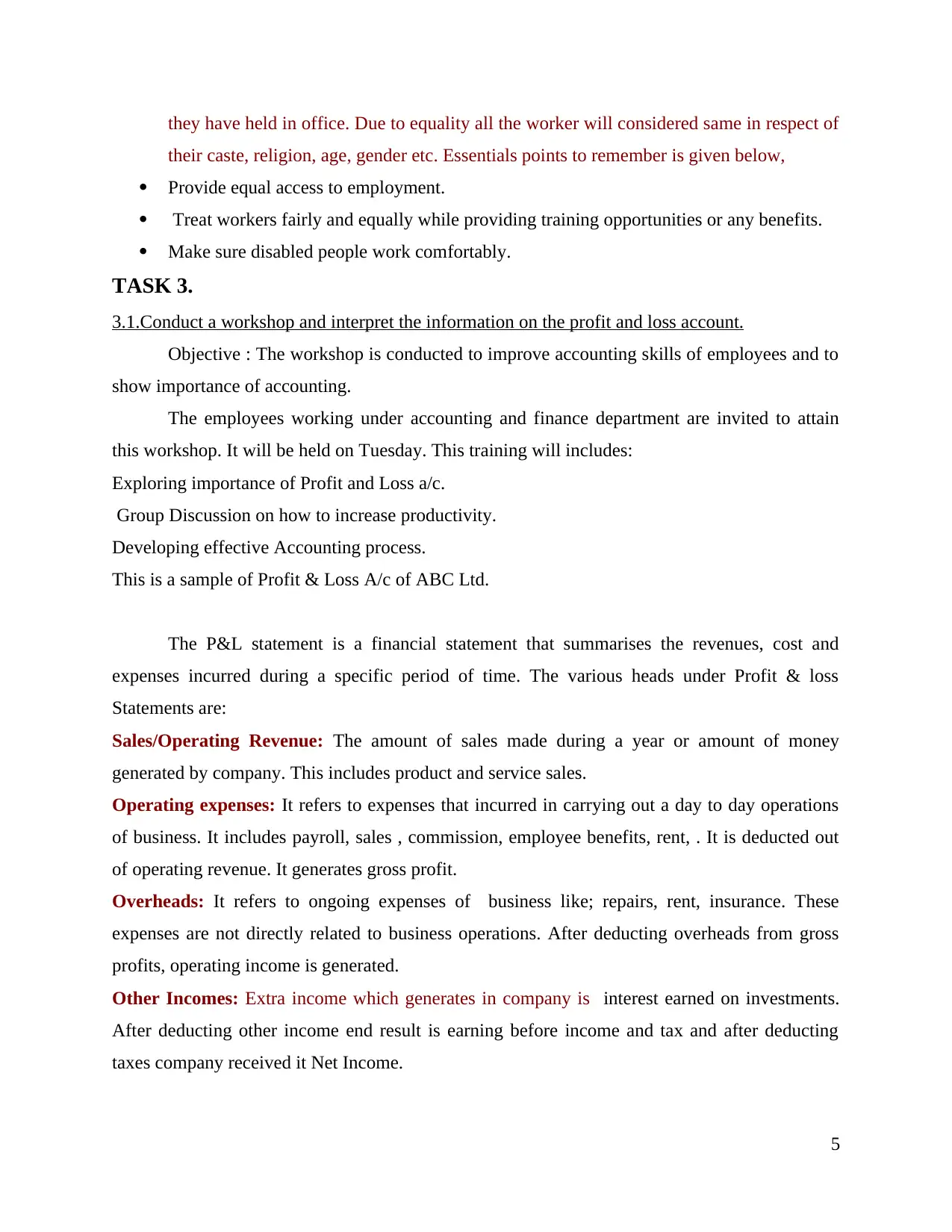
they have held in office. Due to equality all the worker will considered same in respect of
their caste, religion, age, gender etc. Essentials points to remember is given below,
Provide equal access to employment.
Treat workers fairly and equally while providing training opportunities or any benefits.
Make sure disabled people work comfortably.
TASK 3.
3.1.Conduct a workshop and interpret the information on the profit and loss account.
Objective : The workshop is conducted to improve accounting skills of employees and to
show importance of accounting.
The employees working under accounting and finance department are invited to attain
this workshop. It will be held on Tuesday. This training will includes:
Exploring importance of Profit and Loss a/c.
Group Discussion on how to increase productivity.
Developing effective Accounting process.
This is a sample of Profit & Loss A/c of ABC Ltd.
The P&L statement is a financial statement that summarises the revenues, cost and
expenses incurred during a specific period of time. The various heads under Profit & loss
Statements are:
Sales/Operating Revenue: The amount of sales made during a year or amount of money
generated by company. This includes product and service sales.
Operating expenses: It refers to expenses that incurred in carrying out a day to day operations
of business. It includes payroll, sales , commission, employee benefits, rent, . It is deducted out
of operating revenue. It generates gross profit.
Overheads: It refers to ongoing expenses of business like; repairs, rent, insurance. These
expenses are not directly related to business operations. After deducting overheads from gross
profits, operating income is generated.
Other Incomes: Extra income which generates in company is interest earned on investments.
After deducting other income end result is earning before income and tax and after deducting
taxes company received it Net Income.
5
their caste, religion, age, gender etc. Essentials points to remember is given below,
Provide equal access to employment.
Treat workers fairly and equally while providing training opportunities or any benefits.
Make sure disabled people work comfortably.
TASK 3.
3.1.Conduct a workshop and interpret the information on the profit and loss account.
Objective : The workshop is conducted to improve accounting skills of employees and to
show importance of accounting.
The employees working under accounting and finance department are invited to attain
this workshop. It will be held on Tuesday. This training will includes:
Exploring importance of Profit and Loss a/c.
Group Discussion on how to increase productivity.
Developing effective Accounting process.
This is a sample of Profit & Loss A/c of ABC Ltd.
The P&L statement is a financial statement that summarises the revenues, cost and
expenses incurred during a specific period of time. The various heads under Profit & loss
Statements are:
Sales/Operating Revenue: The amount of sales made during a year or amount of money
generated by company. This includes product and service sales.
Operating expenses: It refers to expenses that incurred in carrying out a day to day operations
of business. It includes payroll, sales , commission, employee benefits, rent, . It is deducted out
of operating revenue. It generates gross profit.
Overheads: It refers to ongoing expenses of business like; repairs, rent, insurance. These
expenses are not directly related to business operations. After deducting overheads from gross
profits, operating income is generated.
Other Incomes: Extra income which generates in company is interest earned on investments.
After deducting other income end result is earning before income and tax and after deducting
taxes company received it Net Income.
5
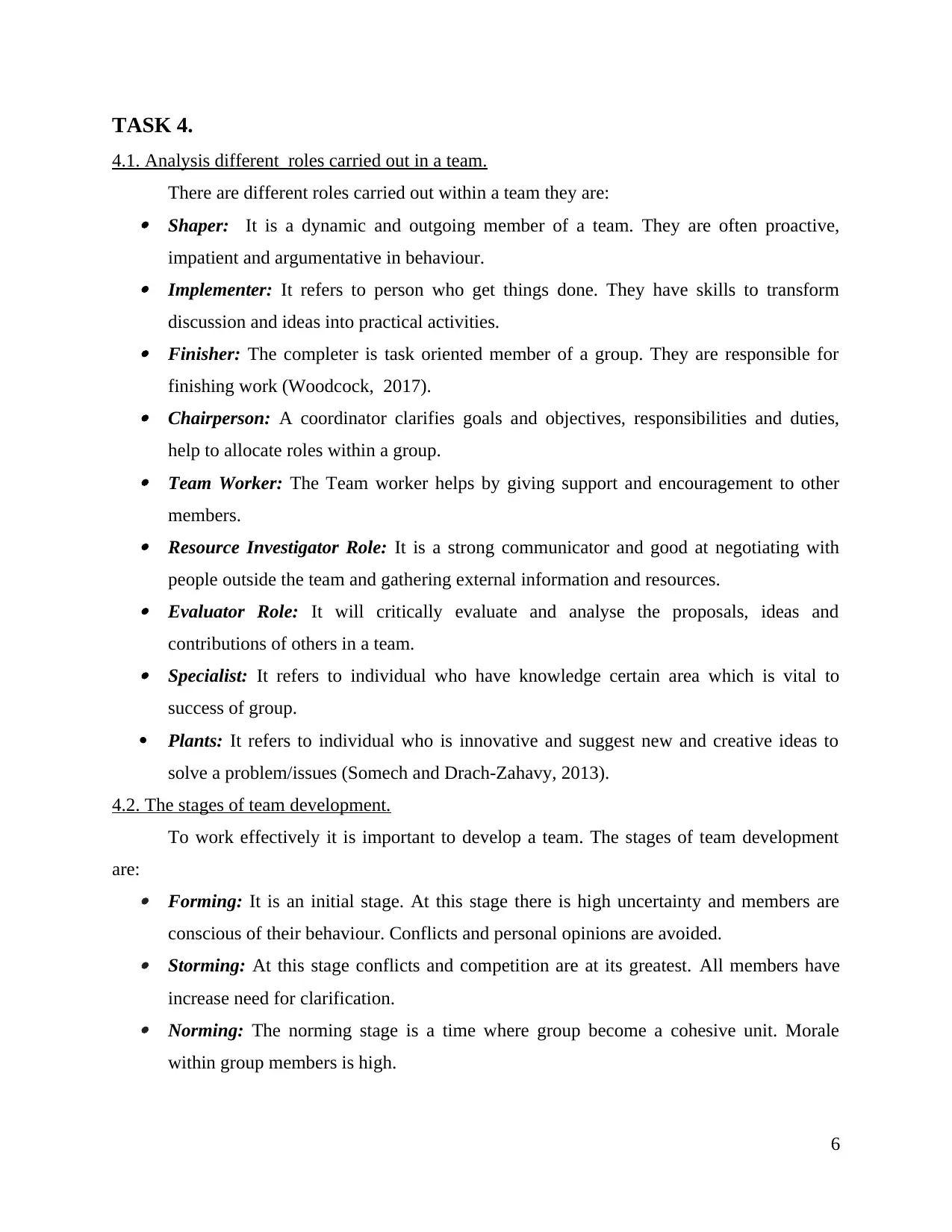
TASK 4.
4.1. Analysis different roles carried out in a team.
There are different roles carried out within a team they are: Shaper: It is a dynamic and outgoing member of a team. They are often proactive,
impatient and argumentative in behaviour. Implementer: It refers to person who get things done. They have skills to transform
discussion and ideas into practical activities. Finisher: The completer is task oriented member of a group. They are responsible for
finishing work (Woodcock, 2017). Chairperson: A coordinator clarifies goals and objectives, responsibilities and duties,
help to allocate roles within a group. Team Worker: The Team worker helps by giving support and encouragement to other
members. Resource Investigator Role: It is a strong communicator and good at negotiating with
people outside the team and gathering external information and resources. Evaluator Role: It will critically evaluate and analyse the proposals, ideas and
contributions of others in a team. Specialist: It refers to individual who have knowledge certain area which is vital to
success of group.
Plants: It refers to individual who is innovative and suggest new and creative ideas to
solve a problem/issues (Somech and Drach-Zahavy, 2013).
4.2. The stages of team development.
To work effectively it is important to develop a team. The stages of team development
are: Forming: It is an initial stage. At this stage there is high uncertainty and members are
conscious of their behaviour. Conflicts and personal opinions are avoided. Storming: At this stage conflicts and competition are at its greatest. All members have
increase need for clarification. Norming: The norming stage is a time where group become a cohesive unit. Morale
within group members is high.
6
4.1. Analysis different roles carried out in a team.
There are different roles carried out within a team they are: Shaper: It is a dynamic and outgoing member of a team. They are often proactive,
impatient and argumentative in behaviour. Implementer: It refers to person who get things done. They have skills to transform
discussion and ideas into practical activities. Finisher: The completer is task oriented member of a group. They are responsible for
finishing work (Woodcock, 2017). Chairperson: A coordinator clarifies goals and objectives, responsibilities and duties,
help to allocate roles within a group. Team Worker: The Team worker helps by giving support and encouragement to other
members. Resource Investigator Role: It is a strong communicator and good at negotiating with
people outside the team and gathering external information and resources. Evaluator Role: It will critically evaluate and analyse the proposals, ideas and
contributions of others in a team. Specialist: It refers to individual who have knowledge certain area which is vital to
success of group.
Plants: It refers to individual who is innovative and suggest new and creative ideas to
solve a problem/issues (Somech and Drach-Zahavy, 2013).
4.2. The stages of team development.
To work effectively it is important to develop a team. The stages of team development
are: Forming: It is an initial stage. At this stage there is high uncertainty and members are
conscious of their behaviour. Conflicts and personal opinions are avoided. Storming: At this stage conflicts and competition are at its greatest. All members have
increase need for clarification. Norming: The norming stage is a time where group become a cohesive unit. Morale
within group members is high.
6
⊘ This is a preview!⊘
Do you want full access?
Subscribe today to unlock all pages.

Trusted by 1+ million students worldwide
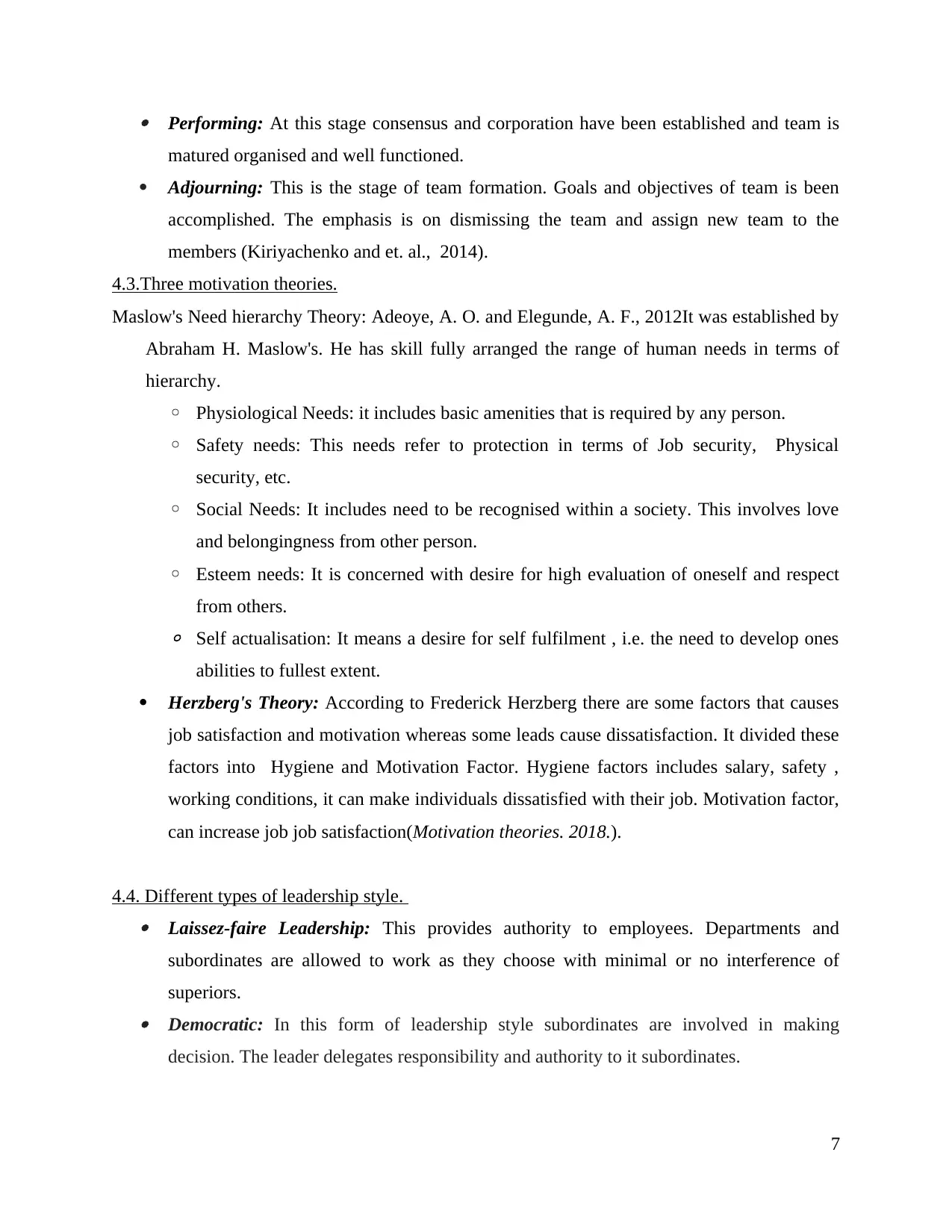
Performing: At this stage consensus and corporation have been established and team is
matured organised and well functioned.
Adjourning: This is the stage of team formation. Goals and objectives of team is been
accomplished. The emphasis is on dismissing the team and assign new team to the
members (Kiriyachenko and et. al., 2014).
4.3.Three motivation theories.
Maslow's Need hierarchy Theory: Adeoye, A. O. and Elegunde, A. F., 2012It was established by
Abraham H. Maslow's. He has skill fully arranged the range of human needs in terms of
hierarchy.
◦ Physiological Needs: it includes basic amenities that is required by any person.
◦ Safety needs: This needs refer to protection in terms of Job security, Physical
security, etc.
◦ Social Needs: It includes need to be recognised within a society. This involves love
and belongingness from other person.
◦ Esteem needs: It is concerned with desire for high evaluation of oneself and respect
from others.
◦ Self actualisation: It means a desire for self fulfilment , i.e. the need to develop ones
abilities to fullest extent.
Herzberg's Theory: According to Frederick Herzberg there are some factors that causes
job satisfaction and motivation whereas some leads cause dissatisfaction. It divided these
factors into Hygiene and Motivation Factor. Hygiene factors includes salary, safety ,
working conditions, it can make individuals dissatisfied with their job. Motivation factor,
can increase job job satisfaction(Motivation theories. 2018.).
4.4. Different types of leadership style. Laissez-faire Leadership: This provides authority to employees. Departments and
subordinates are allowed to work as they choose with minimal or no interference of
superiors. Democratic: In this form of leadership style subordinates are involved in making
decision. The leader delegates responsibility and authority to it subordinates.
7
matured organised and well functioned.
Adjourning: This is the stage of team formation. Goals and objectives of team is been
accomplished. The emphasis is on dismissing the team and assign new team to the
members (Kiriyachenko and et. al., 2014).
4.3.Three motivation theories.
Maslow's Need hierarchy Theory: Adeoye, A. O. and Elegunde, A. F., 2012It was established by
Abraham H. Maslow's. He has skill fully arranged the range of human needs in terms of
hierarchy.
◦ Physiological Needs: it includes basic amenities that is required by any person.
◦ Safety needs: This needs refer to protection in terms of Job security, Physical
security, etc.
◦ Social Needs: It includes need to be recognised within a society. This involves love
and belongingness from other person.
◦ Esteem needs: It is concerned with desire for high evaluation of oneself and respect
from others.
◦ Self actualisation: It means a desire for self fulfilment , i.e. the need to develop ones
abilities to fullest extent.
Herzberg's Theory: According to Frederick Herzberg there are some factors that causes
job satisfaction and motivation whereas some leads cause dissatisfaction. It divided these
factors into Hygiene and Motivation Factor. Hygiene factors includes salary, safety ,
working conditions, it can make individuals dissatisfied with their job. Motivation factor,
can increase job job satisfaction(Motivation theories. 2018.).
4.4. Different types of leadership style. Laissez-faire Leadership: This provides authority to employees. Departments and
subordinates are allowed to work as they choose with minimal or no interference of
superiors. Democratic: In this form of leadership style subordinates are involved in making
decision. The leader delegates responsibility and authority to it subordinates.
7
Paraphrase This Document
Need a fresh take? Get an instant paraphrase of this document with our AI Paraphraser
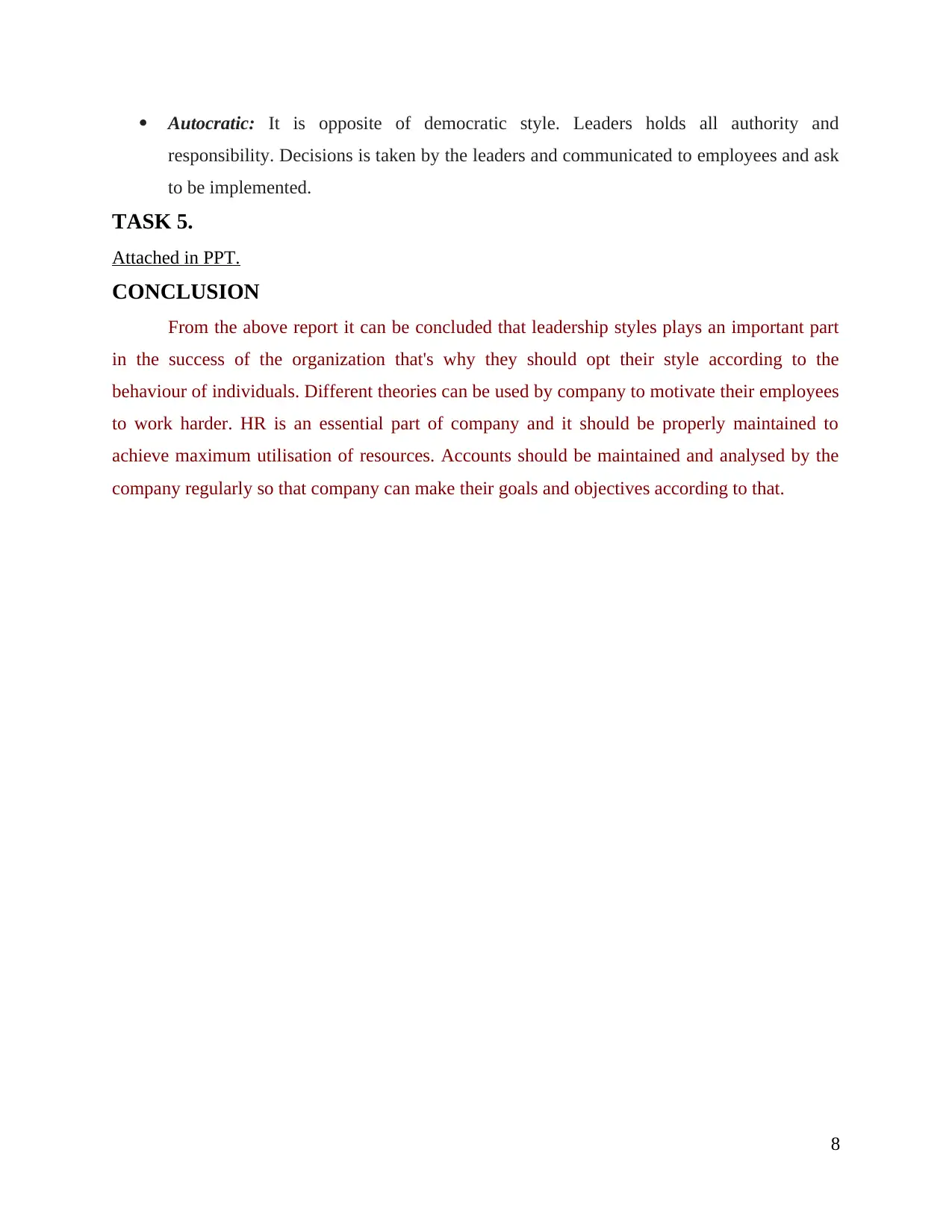
Autocratic: It is opposite of democratic style. Leaders holds all authority and
responsibility. Decisions is taken by the leaders and communicated to employees and ask
to be implemented.
TASK 5.
Attached in PPT.
CONCLUSION
From the above report it can be concluded that leadership styles plays an important part
in the success of the organization that's why they should opt their style according to the
behaviour of individuals. Different theories can be used by company to motivate their employees
to work harder. HR is an essential part of company and it should be properly maintained to
achieve maximum utilisation of resources. Accounts should be maintained and analysed by the
company regularly so that company can make their goals and objectives according to that.
8
responsibility. Decisions is taken by the leaders and communicated to employees and ask
to be implemented.
TASK 5.
Attached in PPT.
CONCLUSION
From the above report it can be concluded that leadership styles plays an important part
in the success of the organization that's why they should opt their style according to the
behaviour of individuals. Different theories can be used by company to motivate their employees
to work harder. HR is an essential part of company and it should be properly maintained to
achieve maximum utilisation of resources. Accounts should be maintained and analysed by the
company regularly so that company can make their goals and objectives according to that.
8
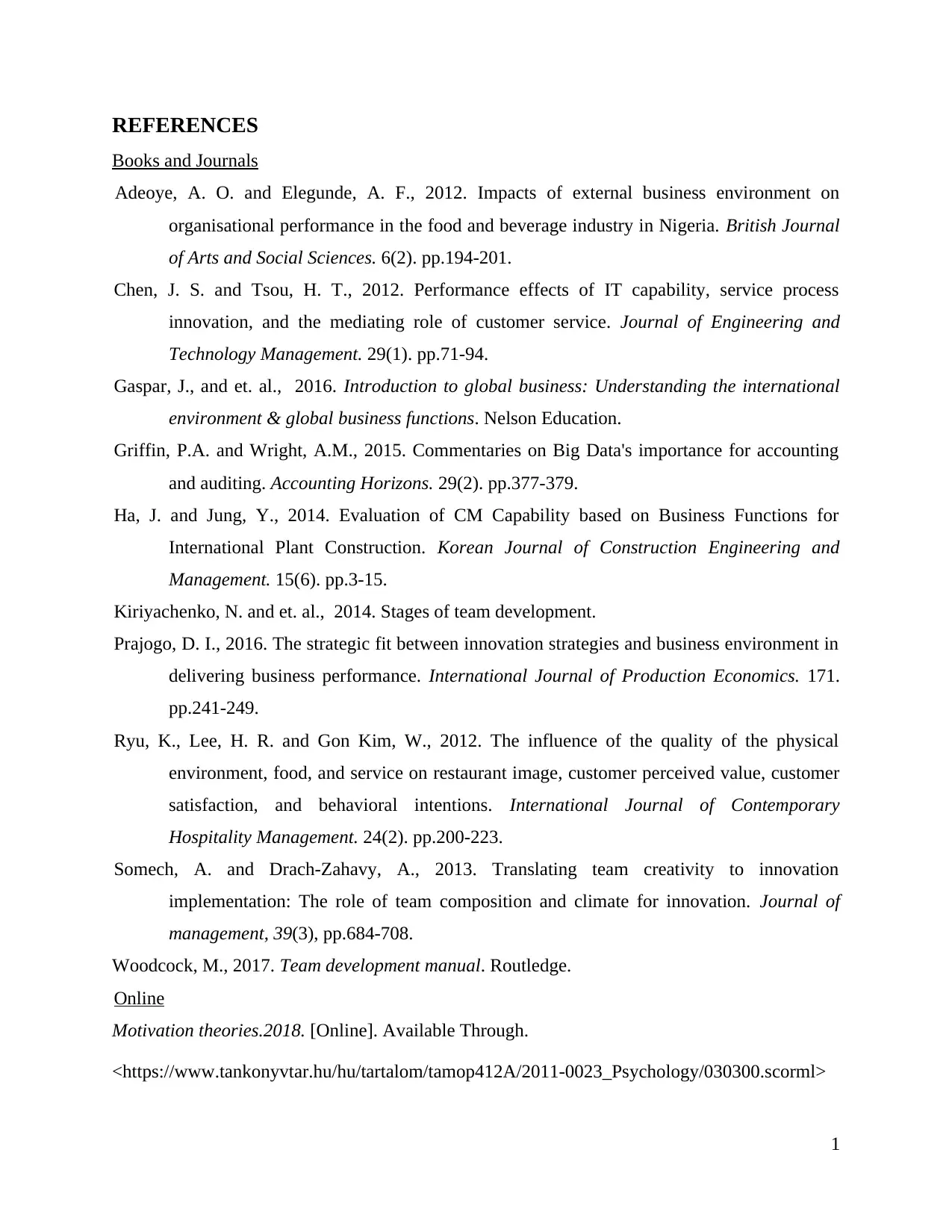
REFERENCES
Books and Journals
Adeoye, A. O. and Elegunde, A. F., 2012. Impacts of external business environment on
organisational performance in the food and beverage industry in Nigeria. British Journal
of Arts and Social Sciences. 6(2). pp.194-201.
Chen, J. S. and Tsou, H. T., 2012. Performance effects of IT capability, service process
innovation, and the mediating role of customer service. Journal of Engineering and
Technology Management. 29(1). pp.71-94.
Gaspar, J., and et. al., 2016. Introduction to global business: Understanding the international
environment & global business functions. Nelson Education.
Griffin, P.A. and Wright, A.M., 2015. Commentaries on Big Data's importance for accounting
and auditing. Accounting Horizons. 29(2). pp.377-379.
Ha, J. and Jung, Y., 2014. Evaluation of CM Capability based on Business Functions for
International Plant Construction. Korean Journal of Construction Engineering and
Management. 15(6). pp.3-15.
Kiriyachenko, N. and et. al., 2014. Stages of team development.
Prajogo, D. I., 2016. The strategic fit between innovation strategies and business environment in
delivering business performance. International Journal of Production Economics. 171.
pp.241-249.
Ryu, K., Lee, H. R. and Gon Kim, W., 2012. The influence of the quality of the physical
environment, food, and service on restaurant image, customer perceived value, customer
satisfaction, and behavioral intentions. International Journal of Contemporary
Hospitality Management. 24(2). pp.200-223.
Somech, A. and Drach-Zahavy, A., 2013. Translating team creativity to innovation
implementation: The role of team composition and climate for innovation. Journal of
management, 39(3), pp.684-708.
Woodcock, M., 2017. Team development manual. Routledge.
Online
Motivation theories.2018. [Online]. Available Through.
<https://www.tankonyvtar.hu/hu/tartalom/tamop412A/2011-0023_Psychology/030300.scorml>
1
Books and Journals
Adeoye, A. O. and Elegunde, A. F., 2012. Impacts of external business environment on
organisational performance in the food and beverage industry in Nigeria. British Journal
of Arts and Social Sciences. 6(2). pp.194-201.
Chen, J. S. and Tsou, H. T., 2012. Performance effects of IT capability, service process
innovation, and the mediating role of customer service. Journal of Engineering and
Technology Management. 29(1). pp.71-94.
Gaspar, J., and et. al., 2016. Introduction to global business: Understanding the international
environment & global business functions. Nelson Education.
Griffin, P.A. and Wright, A.M., 2015. Commentaries on Big Data's importance for accounting
and auditing. Accounting Horizons. 29(2). pp.377-379.
Ha, J. and Jung, Y., 2014. Evaluation of CM Capability based on Business Functions for
International Plant Construction. Korean Journal of Construction Engineering and
Management. 15(6). pp.3-15.
Kiriyachenko, N. and et. al., 2014. Stages of team development.
Prajogo, D. I., 2016. The strategic fit between innovation strategies and business environment in
delivering business performance. International Journal of Production Economics. 171.
pp.241-249.
Ryu, K., Lee, H. R. and Gon Kim, W., 2012. The influence of the quality of the physical
environment, food, and service on restaurant image, customer perceived value, customer
satisfaction, and behavioral intentions. International Journal of Contemporary
Hospitality Management. 24(2). pp.200-223.
Somech, A. and Drach-Zahavy, A., 2013. Translating team creativity to innovation
implementation: The role of team composition and climate for innovation. Journal of
management, 39(3), pp.684-708.
Woodcock, M., 2017. Team development manual. Routledge.
Online
Motivation theories.2018. [Online]. Available Through.
<https://www.tankonyvtar.hu/hu/tartalom/tamop412A/2011-0023_Psychology/030300.scorml>
1
⊘ This is a preview!⊘
Do you want full access?
Subscribe today to unlock all pages.

Trusted by 1+ million students worldwide

2
1 out of 10
Related Documents
Your All-in-One AI-Powered Toolkit for Academic Success.
+13062052269
info@desklib.com
Available 24*7 on WhatsApp / Email
![[object Object]](/_next/static/media/star-bottom.7253800d.svg)
Unlock your academic potential
Copyright © 2020–2025 A2Z Services. All Rights Reserved. Developed and managed by ZUCOL.




